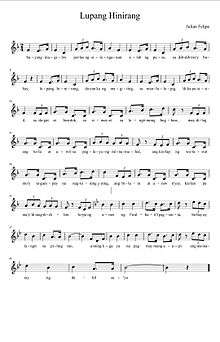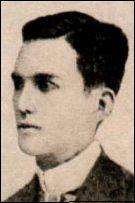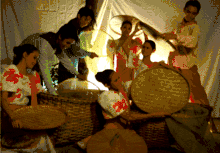Lupang Hinirang
"ᜎᜒᜉᜅ᜔ ᜑᜒᜈᜒᜇᜅ᜔ / Lupang Hinirang" (Tagalog pronunciation: [ˈlupaŋ hiˈniɾaŋ]; lit. '"Chosen Land"'; originally Marcha Nacional Filipina, the "Philippine National March") is the national anthem of the Philippines. Its music was composed in 1898 by Julián Felipe, and the lyrics were adapted from the Spanish poem Filipinas, written by José Palma in 1899. Originally written it did not have lyrics when it was adopted as the anthem of the revolutionary First Philippine Republic and subsequently played during the proclamation of Philippine independence on 12 June 1898.
| English: Chosen Land | |
|---|---|
 Music sheet of Lupang Hinirang | |
National anthem of the | |
| Also known as | Filipinas (Original title of the poem written by Jose Palma) (English: "Beloved Homeland") |
| Lyrics | José Palma (original Spanish lyrics), 1899 |
| Music | Julián Felipe, 1898 |
| Adopted |
|
| Audio sample | |
"Lupang Hinirang" (instrumental)
| |
Under American rule, the Flag Act of 1907 prohibited the public display of flags, banners, emblems, or devices used by revolutionaries in the Philippine–American War.[1] Under this law, the colonial government banned the song from being played.[2] The Flag Law was repealed in 1919. Under the Commonwealth, Commonwealth Act № 382, approved on September 5, 1938, officially adopted the musical arrangement and composition by Julián Felipe as the national anthem.
The Spanish lyrics were translated into Tagalog beginning in the 1940s, with the current Filipino version from 1956 undergoing a slight revision in the 1960s. Over the years, several English versions came into use. On 12 February 1998, Republic Act № 8491 codified the current Filipino lyrics into law.[1]
Etymology
Some English language sources erroneously translate Lupang Hinirang as "Beloved Land" or "Beloved Country";[3][4] the first term is actually a translation of the incipit of the original poem Filipinas (Tierra adorada), while "Beloved Country" is a translation of Bayang Magiliw, the current version's incipit and colloquial name. Some sources assert that an English version of anthem lyrics titled "The Philippine Hymn" was legalised by Commonwealth Act № 382.[5] That Act, however, only concerns itself with the instrumental composition by Julián Felipe.
History


"Lupang Hinirang" began as incidental music which President Emilio Aguinaldo commissioned for use in the proclamation of Philippine independence from Spain. This task was given to Julián Felipe and was to replace a march which Aguinaldo had deemed unsatisfactory. The original title of this new march was "Marcha Filipina-Magdalo" ("Philippine-Magdalo March"), and was later changed to "Marcha Nacional Filipina" ("Philippine National March") upon its adoption as the national anthem of the First Philippine Republic on 11 June 1898, a day before independence was to be proclaimed.
Felipe said that he had based his composition on three other musical pieces: the "Marcha Real", which is the current Spanish national anthem; the "Grand March" from Giuseppe Verdi's Aida; and the French national anthem, "La Marseillaise".[6] It was played by the Banda San Francisco de Malabon (now called the Banda Matanda, from present-day General Trias) during the proclamation rites on 12 June.
In August 1899, the soldier and writer José Palma penned the Spanish poem Filipinas during his stay in Casa Hacienda in Bautista, Pangasinan. The poem was published for the first time for the first anniversary of the newspaper La Independencia on 3 September 1899, and was subsequently set to the tune of the "Marcha Nacional Filipina".[7][8]
Philippine law requires that the anthem always be rendered in accordance with Felipe's original musical arrangement and composition, but the original holograph cannot be located.[1][9] In the 1920s, the time signature was changed from 2/4 to 4/4 to facilitate its singing and the key was changed from the original C major to G.[9]
After the repeal of the Flag Act of 1907 (which banned the use of revolutionary and Katipunan symbols) in 1919, the Insular Government decided to translate the hymn from its original Spanish to English. The first translation was written around that time by the renowned poet Paz Marquez Benitez of the University of the Philippines. The most popular translation, called the "Philippine Hymn", was written by Senator Camilo Osías and an American, Mary A. Lane.
Tagalog translations began appearing in the 1940s, with the first known one titled Diwa ng Bayan ("Spirit of the Country"), which was sung during the Japanese occupation of the Philippines. The second most popular one was O Sintang Lupa ("O Beloved Land") by Julián Cruz Balmaceda, Ildefonso Santos, and Francisco Caballo; this was adopted as the official version in 1948. Upon the adoption of Diwa ng Bayan, the song Awit sa Paglikha ng Bagong Pilipinas and the Japanese national anthem Kimigayo were replaced.[10]
During the term of President Ramon Magsaysay, Education Secretary Gregorio Hernández formed a commission to revise the lyrics. On 26 May 1956, the Pilipino translation "Lupang Hinirang" was sung for the first time. Minor revisions were made in the 1960s, and it is this version by Felipe Padilla de León which is presently used.
The Martial Law years from 1972–1981 during the second term of Ferdinand Marcos up to the 1986 EDSA Revolution saw the use of the National Anthem as the opening protest song of some political and union groups, accompanied by the use of the "raised clenched fist" salute instead of the traditional hand-to-heart salute.
The Filipino[lower-alpha 1] lyrics have been confirmed by Republic Act No. 8491 (the "Flag and Heraldic Code of the Philippines") in 1998, abandoning use of both the Spanish and English versions.[1]
Historian Ambeth Ocampo observed that the Spanish lyrics, which were not intended to be sung when composed, do not flow with the music very well compared to later English and Filipino versions which are smoother. Also, some of the original meanings in Filipinas have been lost in translation; for example, the original Hija del sol de oriente (literally, "Daughter of the Orient (Eastern) Sun") became "Child of the sun returning" in the Philippine Hymn and Perlas ng Silanganan ("Pearl of the Orient") in the present official Tagalog version.[11]
Other anthems
"Lupang Hinirang" was not the first Filipino national anthem to be conceived. The composer and revolutionist Julio Nakpil penned Marangal na Dalit ng Katagalugan (Honourable Hymn of the Katagalugan), which was later called Salve Patria ("Hail, Fatherland"). It was originally intended to be the official anthem of the Katipunan, the secret society that spearheaded the Revolution. It is considered a national anthem because Andrés Bonifacio, the chief founder and Supremo of the Katipunan, converted the organization into a revolutionary government—with himself as President—known as the Republika ng Katagalugan (Tagalog Republic) just before hostilities erupted.[12] The arrangement was by Julio Nakpil, who reconstructed it from memory after the original score was destroyed in 1945 during the battle for Manila. It would later be reworked and incorporated in the orchestral piece, Salve, Filipinas.
The Katipunan or Republika ng Katagalugan was superseded by Aguinaldo's Republica Filipina. The anthem, later renamed Himno Nacional, was never adopted by Aguinaldo for unspecified reasons. The term "Katagalugan" in the anthem referred the Philippine Islands as a whole and not just Tagalophone Filipinos.
The translation of "Lupang Hinirang" was used by Felipe Padilla de Leon as his inspiration for Awit sa Paglikha ng Bagong Pilipinas, commissioned as a replacement anthem by the Japanese-controlled Second Philippine Republic during World War II, and later adapted during the martial law era under President Ferdinand Marcos under the patriotic anthem entitled as Bagong Pagsilang.
Lyrics
The following Spanish, English and Filipino versions of the national anthem have been given official status throughout Philippine history. However, only the most recent and current Filipino version is officially recognised by law. The Flag and Heraldic Code, approved on 12 February 1998 specifies, "The National Anthem shall always be sung in the national language within or outside the country; violation of the law is punishable by a fine and imprisonment.[1] Several bills have been introduced to amend the Flag and Heraldic Code to highlight the importance of complying, abiding and conforming to the standard expression as prescribed by law. As of 2015, none have been enacted into law.[13][14]
| Original Spanish Version Marcha Nacional Filipina (1899)[7][15] penned by José Palma |
Official Commonwealth-Era English Version The Philippine Hymn (1938)[16] |
Official Filipino Version Lupang Hinirang (1958, rev. 1963)[1] translated by Felipe Padilla de León |
|---|---|---|
Tierra adorada |
Land of the morning |
Bayang magiliw, |
Other historical lyrics
| Pre-Commonwealth English version: O Land Beloved (1919)[11][17] translated by Paz Márquez-Benítez |
|---|
|
O land beloved, |
| Official Japanese-era Tagalog version: Diwa ng Bayan (1943)[18] |
Unofficial English translation: Spirit of the Country[lower-alpha 2] |
|---|---|
|
Lupang mapalad, |
Land that is blessed, |
| Post-World War II Tagalog version: O Sintang Lupa (early version c. 1945-1948)[17] translated by Ildefonso Santos |
Unofficial English translation: O Beloved Land[lower-alpha 2] |
|---|---|
|
O sintang lupa, |
O beloved land, |
| Official post-World War II Tagalog version: O Sintang Lupa (1948 revision)[19] translated by Ildefonso Santos |
Unofficial English translation: O Beloved Land[lower-alpha 2] |
|---|---|
|
O sintang lupa, |
O beloved land, |
Misheard lyrics
"Lupang Hinirang" is often taught in schools only during the first year of each educational division (e.g., Grade 1 (in elementary) and Grade 7 (in high school). As time passes, however, students may forget the original lyrics, and replace some words with similar-sounding ones. The most common is the replacement of the word niya (third person possessive; "her/his/its") in "Ang bituin at araw niya" ("its stars and sun") with either nang ("so", "in this manner", "that is") or niya't (contracted "and" with "hers/his").
Other common errors include substitution of na ("when") in "Aming ligaya na 'pag may mang-aapi" ("'Tis our joy when there be oppressor") with "ng" ("of"); "alab" ("flame", "passion") in "Alab ng puso" ("Burning of the heart") with "alam" ("know", "knowledge"); and "mong" (contraction of mo and ng, meaning "yours that is") in "Sa langit mong bughaw" ("in the heavens of yours which is blue") with "mo'y" ("yours is").
Proposed lyrical revision
The final line of the national anthem, Ang mamatay nang dahil sa 'yo (For us thy sons to suffer and die), is subject to certain proposed revisions for being defeatist. in 2013, Filipino musician Joey Ayala, tampered with the national anthem in a forum by changing the last line to ang magmahal ng dahil sa 'yo (to love for the country) and arranged the time signature from 4/4 to 6/8.[20] Senate President Vicente Sotto III suggested that last line should be revised to Ang ipaglaban ang kalayaan mo (To defend thy freedom) as it reflects the commitment of the Filipinos to defend the country's independence.[21]
Music and tempo
| Part of a series on the |
| Culture of the Philippines |
|---|
 |
|
| People |
| Languages |
| Traditions |
|
Mythology and folklore
|
| Cuisine |
| Festivals |
| Religion |
| Art |
| Literature |
|
Music and performing arts
|
|
Media
|
|
Sport
|
|
Monuments
|
|
R.A. 8491 specifies that "Lupang Hinirang" when performed "shall be in accordance with the musical arrangement and composition of Julián Felipe."[9] However, when literally followed, this means that the national anthem should only be performed by a pianist or by a brass band, as these were the only versions that were produced by Julián Felipe.[9] Moreover, the original version was composed in duple time (i.e., in a time signature of 2/4) as compared to the present quadruple time (4/4). It cannot be sung according to the original score, because the music would be so fast that singers would be unable keep pace.[9]
During televised boxing matches featuring Filipino boxer Manny Pacquiao, singers have been both praised and criticized by the National Historical Institute (NHI) for singing too slow or too fast.[22] The NHI says that the proper tempo is a 2/4 and 100 metronomes and that the anthem should last 53 seconds.[22]
Usage and regulation
Article XVI, Section 2 of the 1987 Constitution specifies that "The Congress may, by law, adopt a new name for the country, a national anthem, or a national seal, which shall be truly reflective and symbolic of the ideals, history, and traditions of the people. Such law shall take effect only upon its ratification by the people in a national referendum."[23]
Flag and Heraldic Code of the Philippines
Republic Act № 8491 ("The Flag and Heraldic Code of the Philippines") regulates usage of the National Anthem, and contains the complete lyrics of "Lupang Hinirang".[1] Enacted in 1998, it states that "Lupang Hinirang" when performed "shall always be sung in the national language" regardless if performed inside or outside the Philippines, and specifies that the singing must be done "with fervor".[1]
The Anthem is usually played during public gatherings in the Philippines or in foreign countries where the Filipino audience is sizable. The Code also provides that it be played at other occasions as may be allowed by the National Historical Institute (now known as the National Historical Commission of the Philippines). It prohibits its playing or singing for mere recreation, amusement, or entertainment except during International competitions where the Philippines is the host or has a representative; local competitions; during the "sign-on" and "sign-off" of radio broadcasting and television stations in the country; and before the initial and last screening of films and before the opening of theatre performances.
The Code also specifies the penalties for any entity which violates its provisions. A government official or employee who fails to observe the Flag Code may face administrative sanctions in addition to the penalties imposed by law.
See also
- Marangal na Dalit ng Katagalugan
- Flag of the Philippines
- Oath of Allegiance (Philippines)
- Pledge of Allegiance to the Philippine Flag
Notes
- Spelled with an F since 1973, affirmed in 1987 – see respective Constitutions
- This translation is intended for illustrating the evolution of the Philippine national anthem.
References
- Republic Act No. 8491 (12 February 1998), An Act prescribing the Code of the National Flag,Anthem, Motto, Coat-of-Arms and other heraldic items and devices of the Philippines, retrieved July 23, 2016
- Pomeroy, William J. (1992). The Philippines: Colonialism, Collaboration, and Resistance. International Publishers Co. p. 10. ISBN 0-7178-0692-8. Retrieved 26 January 2008.
Philippines flag law.
; excerpted quote: "In 1909 an entire band was sent to prison for playing the Philippine National Anthem at a festival in Quiapo, Manila.", citing Agoncillo, Teodoro A. (2005). "The Revolt of the Masses: The Story of Bonifacio and the Katipunan". Quezon City: University of the Philippines Press. Cite journal requires|journal=(help) - Colleen A. Sexton (2006). Philippines in Pictures. Twenty-First Century Books. p. 69. ISBN 978-0-8225-2677-3.
- Marshall Cavendish Corporation (September 2007). World and Its Peoples: Malaysia, Philippines, Singapore, and Brunei. Marshall Cavendish. p. 1242. ISBN 978-0-7614-7642-9.
- "Philippines". nationalanthems.info. Retrieved 2015-12-26.
- "The National Anthem's predecessor and influences". Malacañang Palace. Retrieved 2015-12-26.
- The original text, as published in Barcelona, Spain in 1912: Palma, José (1912). Melancólicas: Coleccion de Poesías. Manila, Philippines: Liberería Manila Filatélica. (Digital copy found online at HathiTrust Digital Library on 2010-03-31)
- Contemporary restatements of and comments about the original text:
^ "The Making of Filipinas". The Philippines Centennial. msc.edu.ph. Retrieved 2008-11-12.
^ "The Philippine National Anthem". Filipinas Heritage Library. filipinaslibrary.org.ph. Archived from the original on 2018-08-19. Retrieved 2010-03-30. - Ocampo, Ambeth R. (May 24, 2005). "The right way to sing the National Anthem". Philippines Daily Inquirer. Archived from the original on May 26, 2005. (archived from the original on 26 May 2005)
- Cribb, Robert; Narangoa Li (2003-07-22). Imperial Japan and National Identities in Asia, 1895–1945. Routledge. p. 28. ISBN 0-7007-1482-0.
- Ocampo, Ambeth R. (1995). Mabini's Ghost. Pasig City, Philippines: Anvil Publishing.
- Guerrero, Milagros C. "Andres Bonifacio and the 1896 Revolution". National Commission for culture and the Arts (NCCA). Archived from the original on 18 January 2008. Retrieved 26 September 2007.
- Kate McGeown (5 October 2010). "Philippines national anthem abuse subject to new law". BBC News. Retrieved 12 February 2013.
- Introduced bills:
- "14th Congress : Senate Bill No. 772 : PHILIPPINE NATIONAL ANTHEM". Senate of the Philippines. September 3, 2007.
- "15th Congress : Senate Bill No. 2619 : PHILIPPINE NATIONAL ANTHEM". Senate of the Philippines. December 7, 2010.
- "15th Congress : Senate Bill No. 2691 : PHILIPPINE NATIONAL ANTHEM". Senate of the Philippines. February 15, 2011.
- Pérez-Grueso, María Dolores Elizalde; Elizalde, María Dolores; Fradera, Josep Maria; Álvarez, L. Alonso; Pacífico, Asociación Española de Estudios del; (Spain), Consejo Superior de Investigaciones Científicas (2001). Imperios y naciones en el Pacífico: Colonialismo e identidad nacional en Filipinas y Micronesia (in English and Spanish). Editorial CSIC - CSIC Press. pp. 35–36. ISBN 9788400079383.
- Ambeth R. Ocampo (March 14, 2014). "'Lupang Hinirang' or 'Bayang Magiliw'?". The Philippine Daily Inquirer.
- "Philippine National Anthem". National Library of the Philippines: Digital Collection. Retrieved 8 May 2019.
- Dalmacio Martin (1968). "The Evolution of the National Anthem". Silliman Journal: 4.
- "O Sintang Lupa". Sintunado. Archived from the original on 2012-05-12.
- Joey Ayala's version of 'Lupang Hinirang'
- Sotto wants Philippine national anthem revised
- ABELLA and SOPHIA DEDACE, Jerri (March 14, 2010). "Arnel Pineda's version of RP anthem criticized". GMA News. Retrieved 23 August 2013.
- "1987 Constitution of the Republic of the Philippines". RP Government. Archived from the original on 30 September 2007. Retrieved 26 September 2007.
External links
| Wikisource has original text related to this article: |
| Wikisource has original text related to this article: |
- Various versions of the Philippine National Anthem
- The Philippines: Lupang Hinirang – Audio of the national anthem of the Philippines, with information and lyrics
- Philippine studies – Historical notes: The Philippine National Anthem
- Philippine–American war – Arnaldo Dumindin
- ABS-CBN's Lupang Hinirang YouTube
| Wikimedia Commons has media related to Lupang Hinirang. |